|
DOPEL analysis
The list of
banned organizations
released by the National Assembly of Pakistan during
2012 names as many as 48 organizations that have been
banned or have been put under the watch list. These
organizations have been banned either due to their
direct or indirect involvement in violent activities,
such as hate speech through various means or due to
their separatist or anti state ideologies.
The main idea behind DOPEL is to highlight the various
activities of these banned organizations, which are
undertaken to develop inroads into the society and
various communities living across Pakistan. This
analysis in particular is an effort to describe in
detail the trends followed by these banned organizations
in terms of communication and recruitment and the use of
various tools which ultimately help them in fulfillment
of their organizational objectives. The use of the
various types of media, also termed as Ďmilitantsí
mediaí has been particularly highlighted because it
greatly helps the banned organizations in recruitment.
The banned organizations like
Jaish-e Muhammad (JeM),
Sipah-e Sahaba (SSP),
Lashka-e Jhangvi (LeJ),
Lashkar-e
Taiba (LeT)/Jamat ud-Dawa (JuD) and
Tehrik-e Taliban
Pakistan etc directly recruit from the various madrassahs or religious seminaries that are operating
across the country. However, they donít just rely on
direct recruitment, but also indirectly recruit through
various other means. These means or tools represent the
trends followed by the banned organizations in terms of
communications and recruitment.
The use of Facebook, Twitter, YouTube and various other
social media platforms by the banned organizations has
been highlighted in great detail. This trend points out
that banned organizations are dynamic in terms of
communication and are evolving with the passage of time.
It also points out that these banned organizations donít
just recruit from madrassahs but also target other
segments of the society which are active on the social
media.

In addition to
this, there are other organizations that are not
included in the list but are linked to the banned
organizations in one way or the other. For instance,
certain publishers
publish books by banned organizations.

Similarly, a number of studentís organizations are
linked with banned organizations and carry out their
promotional activities in schools, colleges,
universities and other educational institutes. For
instance, Al-Muhammadiya students Pakistan is associated
with Jamat ud-Dawa, which is a banned organization,
however, Al-Muhammadiya students Pakistan is not
included in the list.

In addition to social media, use of the mainstream media
by the banned organizations has also been highlighted.
However, a number of the mainstream newspapers
previously associated with the proscribed organizations
have been banned, but are still being published online.
There are other newspapers that are not banned but are
ideologically associated with banned organizations.


Similarly, a number of magazines for women, children and
men are associated with banned organizations, which are
still being published.

The social media platform is used by the banned
organizations for promotion of their activities or
communication with the target population.

Social media pages are also used to highlight and
advertise different events, competitions (sports and
others) and publications of banned organizations.
Different slogans associated with banned organizations
are also promoted among the youth on various social
media platforms.




Service
delivery as a tool has also be been highlighted in this
analysis. This is one of the strongest tools used by the
banned organizations. In Pakistan, a number of people
live below the poverty line. This segment of the
population is not always catered by the welfare
activities of the state.
Therefore the banned organizations try to fill the gap
and provide health facilities, shelter to the needy,
provision of charity and matrimonial services etc to
make inroads into various communities. A number of
humanitarian organizations are also linked to these
banned organizations, which carry out relief activities
in flood affected or earthquake affected areas.



Some of the banned organizations also ask their target
groups for various forms of religious taxes such as
Usher (applicable on the agricultural produce) and Zakat
etc. These taxes are collected by the state and not by
any private organization especially when a state is an
Islamic Republic. This way banned organizations also
challenge the writ of the state by acting as a state
within a state.

The detailed analysis has been categorized into various
sub categories, which are the various communication
tools/techniques/approaches used by banned outfits to
target a particular community.
Charity
Charity is considered an important
part of Islam, the religion of the majority (95-98%) in
Pakistan. Taking advantage of this religious obligation,
a number of organizations (religious or nonreligious)
make use of different communication techniques to appeal
to the target community for their charities. There is no
doubt that a number of organizations like Edhi
Foundation are
trusted widely in the country and a number of people
prefer giving them their charities. However, a number of
banned organizations also run promotional campaigns to
ask people for their charities with the promise that
their money will be used for helping the poor. Sadly for
the citizens, their charities are not always used for
the promised cause. Funds collected through charity are
often used to fuel the activities of banned
organizations.
These banned organizations also accept various forms of
religious taxes and charities like Zakat, Khairat and
even usher (agricultural tax). Actually, these religious
taxes are collected by the state and Pakistan has well
developed mechanisms for the collection of these taxes.
However, due to rampant corruption and mismanagement of
the various governments, people donít prefer giving
their religious taxes to the state. Citizens prefer
giving their religious taxes and charities to private
organizations and many of them knowingly or unknowingly
give their money to banned outfits.
Although, different governments have banned a number of
charitable organizations associated with banned outfits
from time to time, but they reappear under new names and
continue their activities. Citizens are often not aware
of name changes, therefore some of them end up giving
their charities to such banned organizations.
For example Al-Rehmat trust is the service delivery side
of Jaish-e-Muhammad. They act as state within a state
because collection of Zakat and Usher is the stateís
responsibility. Through their service delivery
mechanism, these organizations by providing help to
earthquake, floods and other natural calamity victims
they easily get donations and win trust of the affected
communities.

Hate speech
Various banned
organizations in Pakistan are involved in hate speech
against other sects. This hate speech is either directed
towards minority sects or minorities in general.
According unofficial estimates
about 85-90% of the Muslim population in Pakistan
belongs to the Sunni sect, while 10-15% belongs to the
Shiite sect. On the other hand, 3-4 % of the population
belongs to various minority groups such as Christians,
Ahmadis, Hindus and others. Some of these organizations
promote hatred against minority sects particularly
Shiites and Ahmadis. Banned organizations like
Sipah-e
Sahaba Pakistan (SSP) and its associates actively
campaign against Shiites, the second largest religious
community/sect in Pakistan. Ahmadis are discriminated
against in Pakistan in the worst possible manner.
Ahmadis were declared non-Muslims during the 70ís, as
the government at that time wanted to appease the
religious segments of the society. A number of these
banned organizations call the other sects non-Muslims
due to differences in their belief system. The following
example on
Sipah-e Sahaba Pakistanís Facebook page is
promoting hate speech against Shiites.

Expose the Linkages
One the primary aims of this database is to expose the
existing or previously existing linkages of different
banned outfit operating in Pakistan. General Parvaiz
Musharraf proscribed a number of organizations after
joining the war on terror in 2002, however these
organizations continued their work under new names and
kept on running communications campaigns with or without
the help of their linked groups, including banned
organizations, student organizations and even
publishers. For example Dar-ul Andlus publisher is not
banned but it publishes Jihadist literature and
literature for Jamat ud-dawa. Jihadist literature
comprises of books and magazines etc which are published
with the intention of promoting the jihadist ideology.
These books and magazines incite their readers for
joining jihad by terming it as the only solution to
their problems.

Similarly, Al-Mohamdia Students Organization is the
student wing of Sipah-e Sahaba Pakistan. It promotes the
ideology of SSP through various means including
publishing magazines.

Youth, women and children are targeted through an
integrated communication process undertaken by extremist
organizations. Offline and online communication tools
are sometimes used together to target different segments
of the society at the same time. For example the leader
of Jaish-e-Muhammad Masood Azhar writes for
Jaish-e-Mahammadís newspaper Al-Qalam. His column is
available in newspapers, in audio format and is also
reproduced on websites and Facebook pages.
Targeting the Audience
These banned/proscribed organizations not only make use
of service delivery mechanism to reach their target
audience but also involve students, youth, women and
children through competitions, student support programs
and literature. These organizations conduct speech
competitions, writing competitions, summer camps,
quizzes, games competitions and seminars for students.
An example is given below

DOPEL monitored both online and offline tools used by
the banned outfits. It was noted that due to
proscription of these groups, their offline tools are
used only covertly. Their newspapers, magazines, books
and other forms of literature are usually not available
at mainstream book stores, but can be acquired from
bookstores and outlets run by their associates. However,
most of the offline material is reproduced online on
different websites.
The use of offline and online tools in an integrated
manner has helped extremist groups in creating a
dedicated following. Better planning, management and
administration of the various tools of communication has
allowed extremist groups to reach their target audience
most effectively. Details of each and every tool have
been provided in the respective frameworks. The detail
of each and every tool reviewed during our research is
given below:
List of their offline and online tools are given below
Offline
1.
Newspapers
2.
Magazines (for women, children and youth)
3.
Rallies
4.
Speeches
5.
Poems
6.
Sermons (online and offline)
7.
Stickers
8.
Service Delivery
9.
Innovative Products (USBs, wall clocks etc)
10.
Brochures
11.
Leaflets
12.
Pamphlets
13.
Pictures, cartoons, art
14.
Student Wings (with the names of student wings they have
Facebook, web and twitter pages)
15.
Publications
16.
columns
Online
Due to proscription of most of the offline
tools/material, the cyber wings of these banned outfits
actively engage their audience through the various
online tools.
1.
SMS Service
2.
Website
3.
Facebook
4.
Twitter
5.
Blogs
6.
Forums
7.
Radio (and web radio)
8.
Television
9.
Online Magazines and Publications
All the above tools are discussed in detail with
examples in the respective profile of each organization.
However, one example of each tool is described in this
analysis:
Analysis of Offline Tools
Newspapers
Newspapers are used as a tool to convey the various
messages of these outfits to the target audience and
promotion of their activities. This offline tool is
further replicated on Facebook, and different websites.
For example Al-Qalam is a weekly newspaper of Jaish-e
Muhammad, which has website and a Facebook page as well.
This website not only provides the electronic version of
the newspaper but also introduces other publications of
the group. It also provides links to books, audios,
videos, articles, jihadist songs, cartoons and speeches
etc. The website and Facebook page of this newspaper is
given below:
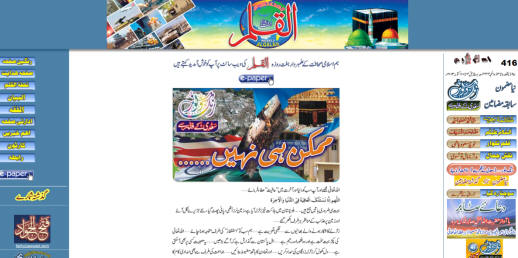

Magazines (for women, children and youth)
In order to target the youth, women and children, a
number of magazines are used by these outfits. Most of
these magazines are published under the name of their
student wings and other linkages. At times direct links
of the banned outfits to these magazines are not found,
because they are not allowed to disseminate their
literature openly. These magazines are also reproduced
on different websites and Facebook pages.
Example of the magazines are given below including
magazine for the youth (Akhbar-e-Talaba), magazine for
women (Banat-e Ayesha) and magazine for children (Bachoon
ka Islam) along with their websites and Facebook pages:



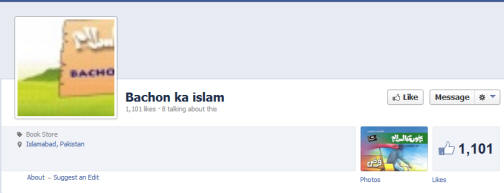
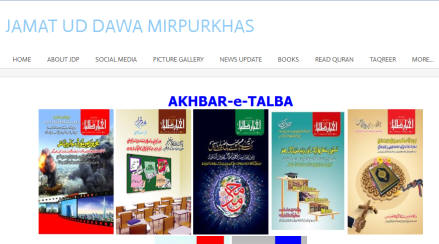

Rallies and Events
The organizations openly organize rallies, conferences,
book launches and seminars. Rallies and events are the
source to distribute their literature, convey their
message and to target the audience. They announce their
events through their magazines, blogs, forums,
pamphlets, wall chalking, posters, banners, bill boards
and banners on local transport (Rickshaws) and social
media. Pictures of some rallies, events and blend of
different tools are given below:






Speeches
A speech made by a leader always has a profound effect
on the listeners and viewers. Banned outfits make good
use of audio and video speeches made by their various
leaders. These speeches are later reproduced on online
media, social media and websites. An example is given
below:
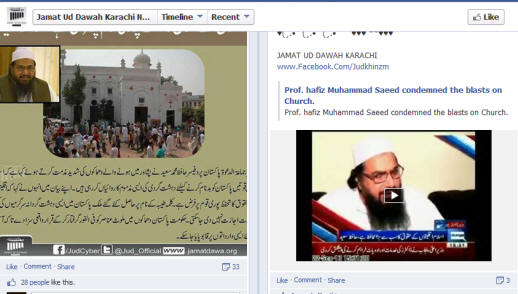


Poems/Songs
Songs and poems have always been used by humans as means
of inspiration. The banned organizations are also aware
of this fact and hence use it to promote the jihadist
fervor and ideology among their recruits and followers.
A number of the Jihadist songs are available in Urdu,
Punjabi, Saraiki and Arabic languages on their websites:

Sermons (online and offline)
Sermons made by the various leaders of the banned
outfits described in this database are recorded and made
available both online and offline.
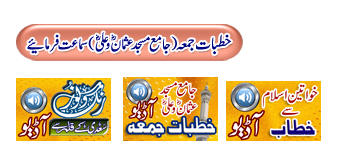
Stickers
Downloadable stickers are available on their blogs,
websites and Facebook.


Service Delivery
Advertisements of their community services are available
on websites, magazines, newspapers and social media.
Including filter plants, marriage bureaus, medical
services and relief activities.

Innovative Products (USBs, wall clocks etc)
A Jihadist wall clock that is branded with Jaish-e
Muhammadís flag and another product, a memory card (8GB)
containing speeches and video clips of their leaders are
examples of innovation used by these organizations to
target different communities.

Leaflets
Leaflets are produced and disseminated in various
localities to promote the ideology of the various banned
outfits.
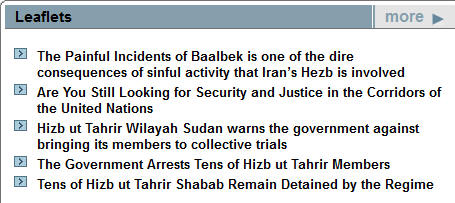
Pamphlets, booklets, and posters
Pamphlets, booklets and posters also serve the purpose
of different banned outfits.

Pictures, cartoons, art
Cartoons help to add humor in the delivery of their
intended messages. Magazines for the children contain
handmade art made and submitted by their readers.
Cartoons are also used as a tool on Facebook pages and
newspapers, which are also available on the website of
such magazines.
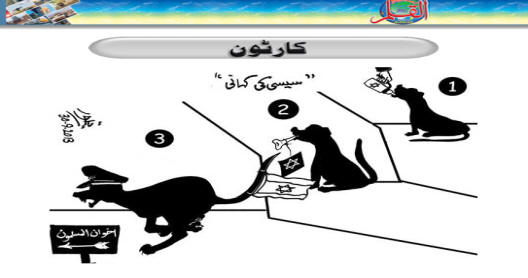



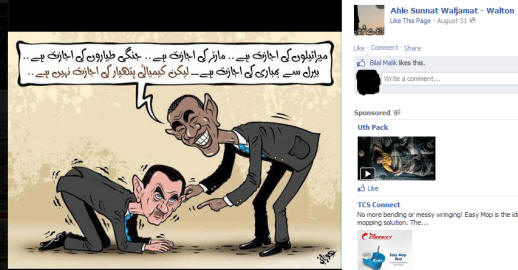
Student Wings
Student wings of different banned outfits are active on
the internet and conduct various activities including
events and rallies etc.
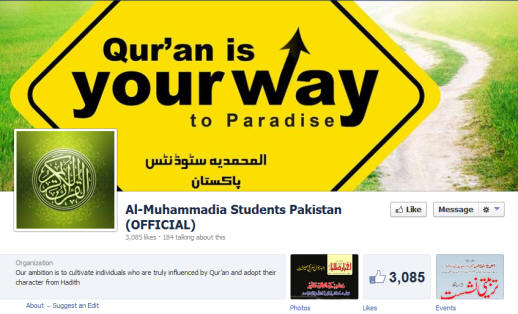
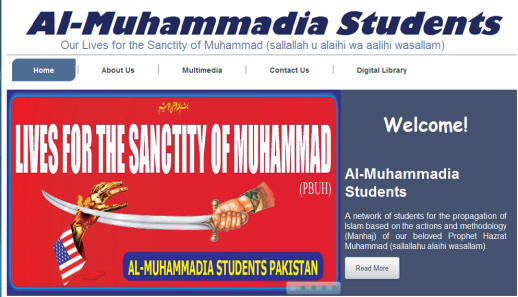
Publications
Publications of their leaders are made available online.
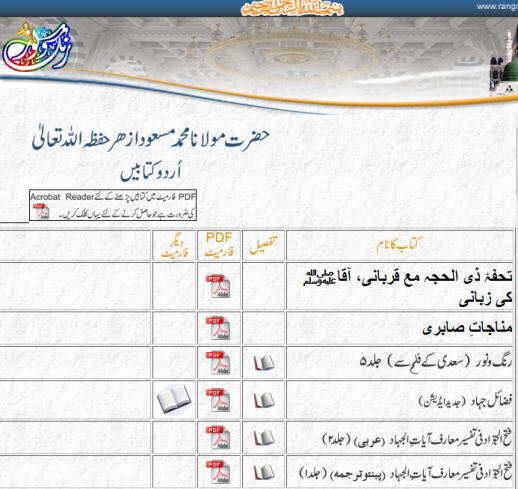
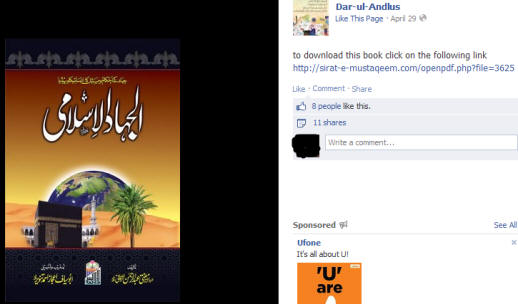
Columns
Rang-o Noor is
column written by Maulana Masood Azhar, founder of JeM
in weekly newspaper Al-Qalam. These articles are
available in readable formats both in Urdu and English
languages and can also be accessed in audio formats.

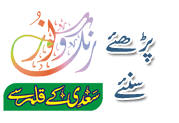
Analysis of Online Tools
SMS Service
SMS services are available including PRING (SMS Service
Website) and some other on all the networks. Anyone can
get news through subscription. They promote their SMS
service through websites and social media.
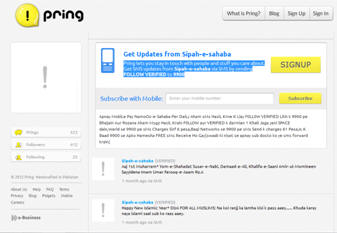
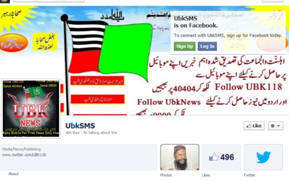
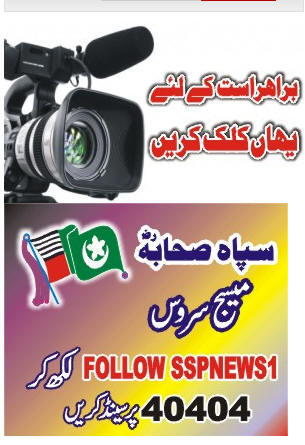
Websites
Literature, audios, videos, news and links of other
websites are advertised on their websites:
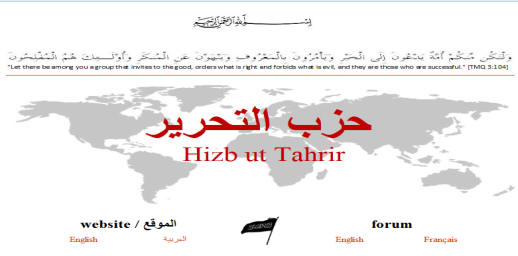
Facebook
There are countless Facebook pages with the name of
these organizations, their trusts, student wings,
publications, magazines, newspapers and leaders. Some of
them are official pages however the others are
unofficial but contain the same message and content
available on official pages. An example of the Facebook
page is given below which is run by a woman, who belongs
to Lashkar-e Jahngvi:
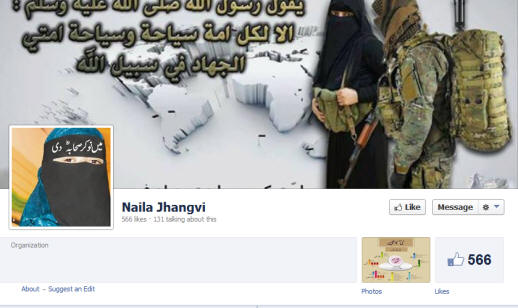
Twitter
A number of organizations have their representatives
running their twitter accounts as well. An example is
given below:
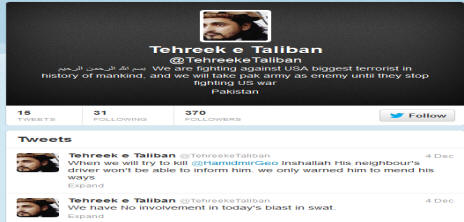
Blogs
This blog contains magazines and newspapers of a number
of banned organizations described in the database.
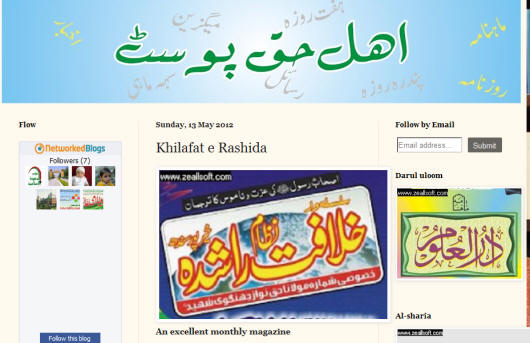
Forums



Radio (and web radio)
1st web radio of
Sipah-e-Sahaba Pakistan is
coming soon they are promoting their web radio through
their Facebook page.
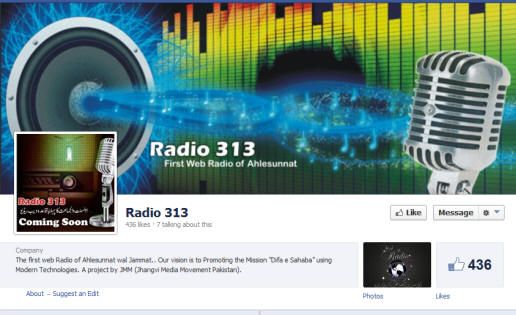
Television
An online television channel run by an associate of
Sipah-e Sahaba Pakistan

Online Magazines and Publications
Sada-e Azeemat is one of the magazines linked with
Sipah-e
Sahaba Pakistanís internet wing. Website of Sada-e
Azeemat have been proscribed (www.sadaeazeemat.com)
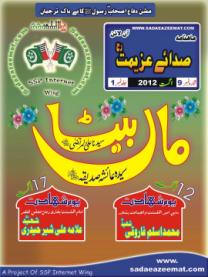
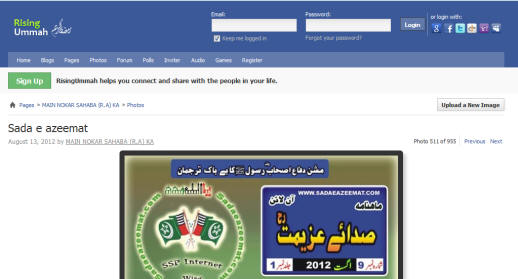
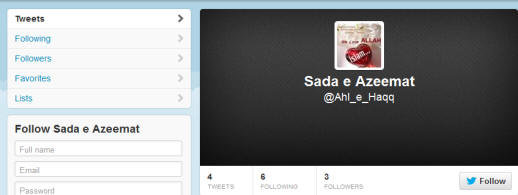
You Tube and other similar websites
Militant organizations make good use of You Tube and
other websites like Tune.pk. The access to You Tube has
been blocked in Pakistan thatís why it was difficult to
access it during our research.
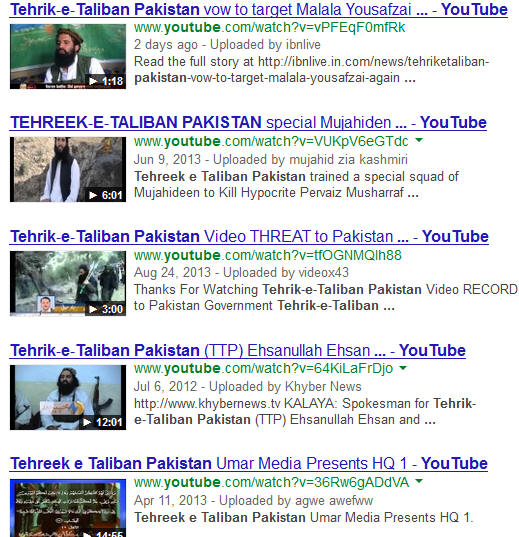
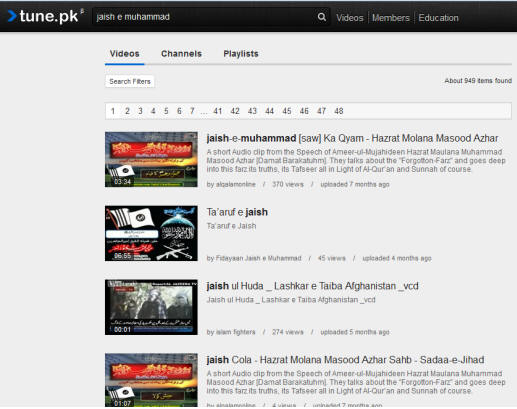
The examples of different online and offline
communications tools used by banned organizations
provide the justification for this database. These
organizations use different communications tools to
target different communities and spread their ideology
which is generally anti-state, spreads hatred and
promotes violence and terrorism in the country. It is
important that the youth, women, children and every
segment of the society is aware of the different
mechanisms used by militant outfits to target them, so
that they donít get caught in the propaganda of these
outfits either knowingly or unknowingly.
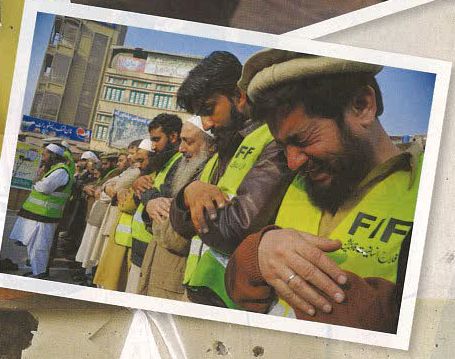
banned
organization's activities highlighted in main stream
newspaper
|